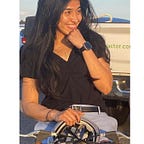I’ve yet to understand the technicality of hyperrealism in art, nonetheless, in photography. Granted, I don’t know the basis nor the difficulty of creating photographs that use hyperrealism. However, I came across this photograph, A Discovery of Witches by Julia Fullerton and stopped scrolling for a second. Certainly my curiosity heightened, and I found myself scrutinizing the variety of faces and body languages displayed across the image. Evidently, we’re supposed to pay close attention to the two subjects at center. All the while, I have a feeling Fullerton designed this image, so the viewer can actively engage with what surrounds the image as a whole in contrast to simply noticing the woman and man who look directly at us. This proposes an interesting paradox. One that can be understood through analysis of what techniques Fullerton uses. In her image above, composition, depth of field and exposure all play a role in creating Fullerton’s image, A Discovery of Witches.
Despite the handful of people scattered about the foreground, middle ground and background, Fullerton directs our attention to the man and woman. She does this by composing the two at center on the middle ground plane. Their placement follows the rule of thirds in which the subjects are within the lines to create a form of symmetry. If the image were physically folded, the woman would fall perfectly on the left flap and alternatively, the man would fall perfectly on the right flap. Additionally, there’s also a slight horizontal symmetry shown with the man positioned on the higher end and the woman on the lower end.
Secondly, I think Fullerton’s strongest tool was how she uses depth of field. It’s interesting to see that Fullerton chooses not to blur the people walking around the two. In most cases I’ve seen, when the photographer wants the viewer to focus on a particular person, the surrounding environment is out of focus. That is- a shallow depth of field. Evidently though, the image portrays a deep depth of field, focusing on both the environment and the subjects at center. And so, every time I look back at the image, I notice something different and write different stories for each person who scurry pass one another, minding their own business and living unique, individual lives. Perhaps, the deep focus on everyone is meant to reinforce this idea of self consciousness. While everyone is busy getting somewhere, the man and woman are the only ones conscious enough to identify that the world doesn’t revolve around them.
To conclude, I think the level of exposure effectively executes one of the possible messages, Fullerton’s tries depicting for us. For example, If we look closely enough, there’s a higher level of exposure, arguably overexposure, on the man and woman compared to everyone else. As shown, it doesn’t mean that those around them don’t have any level of exposure. If anything, the amount of exposure allowed reminds me of the spotlight effect. Simply put, the spotlight effect is a phenomenon that as an individual, when we’re out in public, we carry ourselves as if there’s a spotlight on us. As a result, we might act differently than we would if we were alone. Since everyone aside from the man and woman have the same level of exposure, I think it therefore exemplifies the spotlight effect and supports this notion that, yes, the world is watching you, but at the same time, everyone thinks the world is watching them. In other words, is anyone really paying attention?
Then again, A Discovery of Witches, is also a TV series about Vampires and Witches and Fullerton might have as well drawn inspiration. In other words, there’s a strong chance my analysis leans more to an over the top existential point of view rather than a fact driven synthesis. Either way, I think it makes for a thought provoking dialogue.
